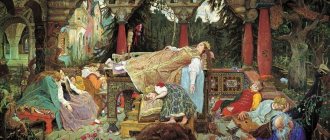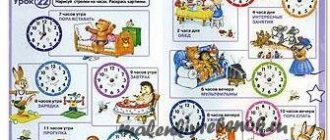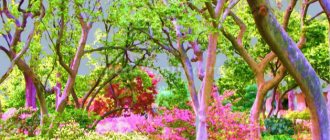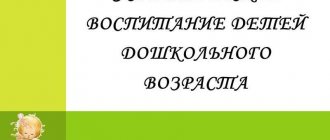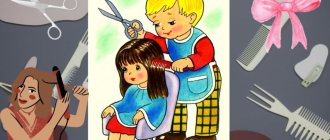Introducing preschoolers to fine arts
The visual activity of preschoolers is understood as artistic activity (modeling, drawing, appliqué), which contributes to the comprehensive development of the child’s personality, active knowledge of the world around him, and the development of the ability to truthfully and creatively reflect his impressions in graphic and plastic form.
Visual activity is one of the most interesting for preschool children: it deeply excites the child and evokes positive emotions. Very early, the child also begins to strive in a wide variety of ways to express the impressions he receives: with movement, words, facial expressions. We must give him the opportunity to expand the area of expression of his emerging images. You need to give him material: clay for modeling, pencils and paper, any material for buildings, etc., teach him how to handle this material. The material expression of existing images serves as an excellent means of testing and enriching them. We must encourage children's creativity in every possible way, no matter in what form it may be expressed.
Drawing, modeling, and design classes develop such personality traits as perseverance, focus, accuracy, and hard work.
One of the means of aesthetic development of preschool children is fine art.
General tasks for introducing children to works of fine art:
— To form the emotional culture of children, to teach them to feel the mood, the character of a work, to be happy, sad, empathize with the characters, to react emotionally to an artistic image.
— Distinguish between types and genres of fine art.
— To introduce the work of Russian and Soviet artists, and some works of world art.
— Identify the expressive means of each type of creativity, understand the language of art.
— To develop interest in museums, exhibitions, and original works of fine art.
— Develop aesthetic perception, artistic taste.
Forms of work:
— visiting exhibitions;
— classes to introduce children to art;
— classes in drawing, modeling, appliqué.
With children of primary and secondary preschool age, the work of one artist is first studied; from the second half of the year, exhibitions are organized where children can compare the works of this artist, as well as see the works of other artists. Children, looking at works of art - graphics, small sculptures, recognize familiar images, name the artists, learn to identify images of animals - real and fabulous, expressive means used by the artist (colors, their tones, background and foreground, main and secondary characters, their clothes, etc.).
Children are taught to see the content, identify and name characters, determine their character, mood and how it was conveyed by an artist, sculptor, or folk craftsman.
Classes to introduce works of fine art to children of senior preschool age are held at least once a month. A lesson can be devoted to one type of art (painting, graphics, etc.), one genre (portrait, landscape, still life, etc.).
One of the types of fine art is graphics. This is a drawing made by the artist on paper, cardboard, pencil, pen, charcoal, pastel, brush, as well as with the help of special devices and machines that print a large number of copies.
Objectives of graphics classes.
Teach children:
- understand the content of the book and recognize the characters, highlight the features of their appearance, determine their character and mood;
- recognize some artists by their drawing style, features of the content of the image;
- highlight expressive means (color, composition, decorations, clothing, pose, movement, materials).
Sculpture is one of the types of fine art that conveys the richness and versatility of the human image, with its proportions, plasticity of movement, facial expressions, internal content and mood.
Tasks:
1. To cultivate in children an interest in sculpture, a caring attitude towards it as a work of fine art, and emotional responsiveness.
2. Distinguish between small and monumental sculpture.
3. See images of animals and humans in sculpture, characteristic features of appearance, mood, understand the content.
4. Identify means of expression: three-dimensional form, character of movement, position of the figure, facial expression, character and mood of images, expressiveness of materials (wood, ceramics, porcelain, etc.).
5. Introduce the work of the sculptor.
To work with children to get acquainted with sculpture, you need the following:
- Study the monumental sculpture of your area, city, choose one to which you can take an excursion with your children or which they drive past or pass with their parents.
— Find out where the nearest museums, exhibition halls, art salons or museums are located.
— Find out if there is a sculpture workshop nearby where you could introduce children to the work of the sculptor.
— Purchase a small sculpture for a preschool institution.
The joint work of the teacher and parents will help show children the variety of sculpture.
It is necessary to select and study literature about sculpture and sculptors in order to understand the purpose of sculpture, its specific language of expressive means, and learn to clearly talk about all this to children.
Forms of work organization:
1. Exhibitions.
2. Classes to get acquainted with small-form sculpture and monumental sculpture.
3. Classes in visual arts, where work on getting acquainted with sculpture will continue.
Getting to know sculpture is part of a lesson in drawing, sculpting, and appliqué. For classes, images are selected that are then reflected in the drawing task (sculpting, appliqué).
Sculpture can be used at the beginning of a lesson to create interest in the task - showing an object in different types of fine art (graphics, sculpture, folk toys) in order to highlight the common features of this image.
Architecture is the art of creating buildings and structures according to the laws of beauty. The main principles in architecture are: utility, strength, beauty, which are interconnected.
Depending on the era, various materials and technologies are used in architecture (stone, wood, brick, concrete, glass, etc.).
When introducing preschoolers to architecture, the following tasks are distinguished:
— Learn to see the appearance of your street, district, city, village.
- See the features of buildings, their purpose, the shape of buildings, windows, doors, balconies, their location and decoration, color schemes.
— Learn to compare old and modern buildings, see their differences.
— Highlight stained glass windows, mosaics, frescoes, bas-reliefs, sculpture, etc. in the decoration of buildings.
— Highlight the means of expressiveness of architecture (plasticity of volumes, scale, proportionality, etc.).
— Highlight the pattern of fences of houses and bridges.
— To introduce landscape gardening architecture.
— Highlight elements of fairy-tale architecture (huts, towers, palaces).
— Reflect in the drawing, appliqué buildings modern, ancient, fabulous.
All work is carried out in two directions:
1. Introduction to architecture:
1.1. Excursions, walks along the streets of the city, village.
Purpose: to consider buildings for different purposes.
1.2. Examine buildings in illustrations, reproductions of paintings, photographs, postcards, videos, etc.
Goal: to show the diversity of architectural styles in the city.
1.3. Looking at illustrations in books depicting fairy-tale buildings.
Goal: to show the unusual shape of these buildings, their roofs, windows, and decorations. Identify the elements of fabulousness
1.4. The use of artistic words, where a description of buildings, houses, mansions is given, a selection of figurative comparisons.
1.5. Teacher's story.
1.6. Questions.
1.7. Listening to music to create a certain image of a building.
2. Images of buildings of different designs and different purposes, modern, ancient, fairy-tale, cities of the future in drawings and applications.
In each kindergarten, the content of the work will be different and it depends on the impressions of the children, on what buildings they looked at, what visual material was shown, what fairy tales they read, what aroused their interest.
The teacher needs to study the architectural features of buildings, houses in his city, district, street. To select the most interesting objects that would be available for depiction by preschool children.
Analysis of the image process shows that to create a drawing, it is necessary to have, on the one hand, clear ideas about those objects and their qualities that should be drawn, on the other hand, the ability to express these ideas in graphic form on the plane of a sheet of paper, to subordinate the movement of the hand to the task of imagination . Consequently, not only a special organization of children is required in order to form the necessary ideas, but also the development of hand movements, the formation of graphic skills and abilities.
Visual activity is invaluable for the all-round development of a child. Being one of the most interesting, it allows children to convey what they see in the life around them, what excited them, caused a positive attitude (and sometimes negative, and fear, and then, drawing these phenomena, the child, as it were, overcomes the feelings caused by them fear).
In the process of visual activity, favorable conditions are created for the development of an aesthetic, emotionally positive perception of art, which contributes to the formation of an aesthetic attitude to reality.
Knowledge of visual arts is of great importance for the mental education of children. This is determined primarily by the fact that this activity is based on art, which contains concentrated information about the time in which the artist lived and worked, about the lives of people, their work, customs, morals, their ideals, standards of goodness and beauty.
The visual activity of preschool children is considered from the perspective of realistic art, which is a special form of social consciousness. In this regard, children's drawing, modeling, and applique are a means of learning and reflecting objects and phenomena of the real world. But before they appear on paper in plan, these images take shape in the child’s mind.
Visual activities in kindergarten are of great importance for preparing children for school.
Literature:
1. Kazakova T. G. Visual activity and artistic development of preschoolers. - M.: Pedagogy, 1983. - 112 p.
2. Komarova T. S. Children's artistic creativity. Methodological manual for educators and teachers. - M.: Mosaic - Synthesis, 2006. - 128 p.
3. Komarova T. S. Teaching preschoolers drawing techniques. - M.: Pedagogical Society of Russia, 2005. - 176 p.
4. Komarova T. S., Zyryanova O. Yu. Continuity in the formation of artistic creativity of children in kindergarten and primary school. - M.: Pedagogical Society of Russia, 2006. - 160 p.
5. Komarova T. S., Savenkov A. I. Collective creativity of preschoolers: textbook. - M.: Pedagogical Society of Russia, 2005. - 128 p.
6. Korchinova O. V. Children's applied creativity. - Rostov n/d: Phoenix, 2007. - 315 p.: ill.
7. Familiarization of preschool children with architecture / ed. A. A. Gribovskaya. - M.: Pedagogical Society of Russia, 2005. - 96 p.
8. Familiarization of preschoolers with graphics and painting / ed. A. A. Gribovskaya. - M.: Pedagogical Society of Russia, 2004. - 192 p.
9. Familiarization of preschoolers with sculpture / ed. A. A. Gribovskaya. - M.: Pedagogical Society of Russia, 2004. - 96 p.
10. Tskvitaria T. A. Non-traditional drawing techniques. Integrated classes in preschool educational institutions. - M.: Sfera, 2011. - 128 p.
Dick Bruna: Miffy in the Museum
It used to be that children in museums were bored and uninteresting, all “no”, “don’t touch with your hands”, “don’t make noise”... Fortunately, the situation is changing. Museum workers are trying to keep up with their Western colleagues and are adopting best practices in organizing exciting museum quests, interactive games, lectures, seminars and other “artistic and educational gadgets” that are gradually returning museums to their lost popularity among the younger generation.
Parents should also help their kids a little. The feeling of beauty is inherent in them from birth. There is a lot in common between an artist and a child. You just need to leave them alone more often...
Kids will find this book about Miffy interesting. Together with the little rabbit Miffy we will find ourselves in the museum. Why not explore different pieces of art?
“The Boy Who Bit Picasso” (Arka Publishing House, 2016)
icanread.ru
Quite informative text, bright color pages, lots of illustrations, play with fonts. The book is a pleasure to hold and look at. There are many photographs and children's drawings made especially for this edition.
www.labirint.ru
One day Picasso was bitten by a boy, and Picasso... bit him back. This boy was Anthony Penrose, the author of the book. Anthony's family was friends with Picasso, so Tony wanted to talk about his amazing adult friend, who could and knew how to do many interesting things.
www.labirint.ru
We see the great Pablo Picasso through the eyes of a child, we begin to look at his paintings and sculptures in a completely different way, page by page we plunge into an amazing world. We learn about the artist’s family, his surroundings, and hobbies. What seemed strange and absurd begins to come to life and be filled with meaning. We begin to understand the artist, we admire how he knew how to see the interesting and mysterious in simple things. In a broken pot he saw a wonderful little baby, for whom he later also came up with a mother with a stroller. The car became the face of a monkey.
The writer talks about his friend with such warmth and love that it is simply impossible not to fall in love with Picasso.
“For many, many years, Picasso continued to create. When he died - and he was already 91 years old - he left almost TWO THOUSAND paintings, more than SEVEN THOUSAND drawings, more than a THOUSAND sculptures and much, much more. Today he is considered one of the most famous artists in the world... but to me he will always be my most amazing friend, and I hope that he is now a friend to you too."
